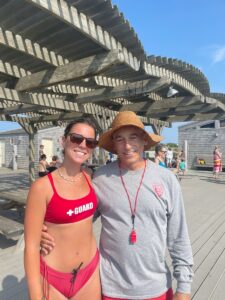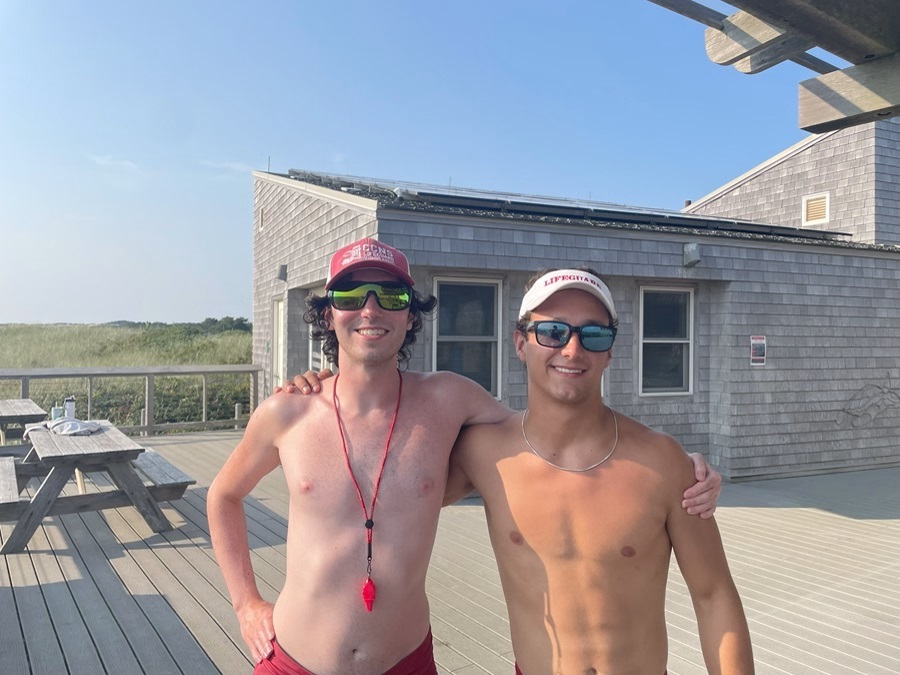PROVINCETOWN — Alan Weaver is a real estate broker in Hudson, N.Y. for most of the year, but this summer he’s a lifeguard at Herring Cove Beach in Provincetown. With white hair sticking out from under his floppy brown hat, he stands out among his colleagues.
Weaver, 65, is a first-year guard, as are several of his college-age colleagues — proof that while lifeguarding can be a way station for students and recent graduates, not everyone fits the stereotype.
“I like working with them,” Weaver says of his younger colleagues. “Hopefully they like working with me, and if not, tough.”

Long hours watching the water in pairs from the lifeguards’ chair makes the group tight-knit. Six guards cover Herring Cove through the summer, but only four are at the beach each day. Collette Spring, 20, from Pembroke, who studies at UMass Dartmouth and is in her second year at Herring Cove, says she likes that she gets to meet a variety of people.
“When would I ever sit with a random 65-year-old man on a chair for eight hours a day?” Spring says. “But in the best way possible.”
Weaver got himself recertified after hearing about the lifeguard job at the National Seashore from a friend. He has visited Provincetown every year since 2011 in September to participate in the Swim for Life. He applied three times before being hired, he says.
“I haven’t had to apply for a job in about 40 years,” says Weaver, who’s a self-employed broker.
The lifeguards arrive at 9 a.m. They change, hang out, and usually have breakfast together while setting up the beach for the day. Conversations often drift to what people did the night before — Weaver’s report is nearly always that he turned in early.
This relaxed part of the workday is important to the crew. “We call it family time,” Spring says.
After setting up, the crew starts workouts. The pair not sitting chooses an exercise: swimming, paddling, running, or a trip to a nearby ranger gym, says Spring. After 75 to 90 minutes, the pairs switch places. Shifts for the rest of the day rotate between an hour on the stand and an hour on break, she says.
After 5 p.m. the lifeguards have another round of family time, says Sam Patry, 21, from Medfield, another first-year guard. The four often play volleyball or toss around a football —play keeps things friendly between co-workers, he says.

At the end of the summer, the guards make plaques out of “torps,” or torpedo rescue buoys — small pill-shaped flotation devices. The plaques include “beach names” for each employee, often referring to gentle inside jokes, Spring says. Last summer, Spring called herself “Queen of the Cove” in conversations, but her colleagues wouldn’t let her claim the title because she hadn’t been on the job long enough.
She got to be Collette, Duchess of the Cove instead. Maybe she’ll become Queen this year, but a different nickname may await — she doesn’t know.
Like Spring and Patry, Nathan Greene, 21, who is in his first year with the National Seashore, wants to return next year. But unlike his co-workers, Greene wants to be a “lifer,” coming back to the beach as a lifeguard year after year.
“I guess I can say I’m following a tradition,” says Greene, from Troy, N.Y. His mother worked for the National Seashore for over two decades, beginning when she was around his age, he says.
Under the glare of the late afternoon sun, beachgoers begin gathering their things. Families wait by foot showers to wash off a day’s worth of sand. Someone at Far Land’s snack bar pulls the handwritten menu off its perch. And around 5 p.m., the Herring Cove lifeguards begin carrying items, including the fearsome purple and white shark flag, into the storage room. It’s been a hot one, Patry says, and more heat means less conversation on the stand.
The single lifeguard chair, which is right at the beach’s entrance, stands empty — at least temporarily.
By the time the lifeguards have finished cleaning up, their chair spots have been stolen. A pair of little girls survey the beach from on high, perhaps practicing for their own future seaside summer jobs.
